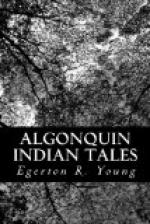“When the ground squirrel, who had for days been attending the council of the trees and plants, had made out his list of what remedies each tree and plant could furnish he was very much delighted, and then, thanking them for their offered assistance, he rapidly returned to the abodes of mankind and informed them of his great success.
“Of course they were very much pleased, and very grateful to the ground squirrel for his kindness and his interest in their happiness. This is the reason why the chipmunk, or ground squirrel, lives near the homes of men. You never see an Indian shoot them or the boys or girls try to snare them. They are always welcome among the trees and the wigwams. The Indians love them because they spoke up for man when the other animals turned against him, and because it was one of their ancestors that made the trees and plants reveal their good medicines for the cure of the sick.”
“Now I know why it was, when I was out with the Indian boys, that they never would shoot an arrow at a chipmunk, even when I asked them to,” said Sagastao.
“Yes,” said Mary, “all of the Indians have heard their fathers tell of the kindness of the old father chipmunk in the days when the animals knew so much and could talk, and so they warn the children against injuring these pretty little creatures.”
But it was now time they were returning. The light canoe was once more pushed down into the lake, and soon they were merrily gliding along over the clear, transparent waters to their cozy home.
CHAPTER XIII.
In the Wigwam of Souwanas—How Gray Wolf Persecuted Waubenoo, and How He was Punished by Nanahboozhoo.
“We have come to-day for a nice story about Nanahboozhoo,” said Minnehaha, as she and Sagastao lifted the deerskin door at the wigwam of Souwanas, and entered with all the assurance of children who knew they were welcome.
“Did he ever do anything to punish bad fellows who were cruel to their wives and children?” asked Sagastao. “Because, if he did, I wish he would come and thrash old Wakoo, that bad fellow who has been thrashing his wife again because he said she did not snare enough rabbits to suit him.”
Souwanas, who was one of the kind-hearted Indians, never cruel to any of his family, was much amused at the fire and indignation with which the young lad spoke. So after he had had comfortable seats arranged for the children among the robes and blankets he endeavored to satisfy their demands. “Nanahboozhoo,” he said, “did such things long ago, but once, when he was giving a good thrashing to a man who had been very cruel to his wife, the wife, as soon as she was able, sprang up from the place where her husband had knocked her to, seized a paddle and attacked Nanahboozhoo with such fury that he resolved never to interfere again, if he could help it, in a quarrel between man and wife. And,” added the old man, with a merry twinkle in his eye, “it is best for everybody, if possible, to keep out of such quarrels.”




